WTM 2022: Focus on digital and physical accessibility, experts urge
 Charlotte Cullinan
Charlotte CullinanAccessible travel is a “huge opportunity” for the industry, but greater emphasis is needed on making digital and physical products more user-friendly, according to a panel of experts at WTM.
Speaking on the Accessible Travel: how are we really doing? panel, Rhiannon Parker, chief innovation officer of global business collective The Valuable 500, said 15% of the global population are disabled. This market can aid the growth and recovery of destinations, she said, but highlighted research that showed 95% of all websites are inaccessible to consumers with various disabilities.
Heather Hepburn, accessibility lead at Skyscanner, urged businesses to ensure their digital products were usable for everyone, including those with visual, hearing, physical and cognitive impairments.
“Accessible design isn’t really known about hugely well. It’s a simple concept, but still one that so many people don’t think about,” she added.
Hepburn stressed the importance of building accessibility into the initial requirements for all digital projects. She said Skyscanner offers training for staff, including ‘empathy labs’ where they navigate the brand’s website and app while using equipment such as visual impairment glasses or gloves that mimic the effects of having arthritis.
Discussing the need to improve the built environment, Robin Sheppard, president of UK-based Bespoke Hotels, urged hoteliers to be more ambitious with the design of accessible hotel rooms, and include “flair and joy”. He continued: “We need emotionally intelligent design. It’s the right thing to do, but there’s also a commercial case for it. What can you do to turn the disabled room into the most spectacular room?”
Ross Calladine, head of business support at Visit England, said destination management organisations have a “huge role” to play in driving accessible tourism, and praised the work of the tourist boards in Germany, Portugal, Spain and Flanders.
He continued: “National tourist boards can play a leadership role. They can produce the strategy for the regional and local DMOs to help them understand what an accessible destination looks like. It’s not just a responsibility, but a huge opportunity.”
The panel agreed it was vital that travel marketing reflected those with visible and non-visible disabilities. “How can we subconsciously show that everyone is welcome in our destinations?” Calladine added.
Sign up for weekday travel news and analysis straight to your inbox

Charlotte Cullinan
Supplier Directory
Find contacts for 260+ travel suppliers. Type name, company or destination.















